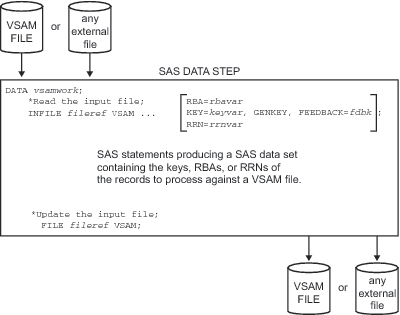Operations on VSAM Data Sets in SAS Programs
SAS programs handle VSAM data sets
the same as any external data set. The following are examples of operations
that SAS can perform on external data sets, which are data sets that are not created by SAS:
The following figure
illustrates a typical SAS DATA step processing a VSAM data set. A
VSAM external data set is shown as input to a SAS DATA step. Only
the INFILE statement with some of the most common special SAS options
and the FILE statement are shown. Notice that both the INFILE and
FILE statements specify the VSAM option and the fileref that refers
to the VSAM data set. The RBA=, KEY=, and RRN= direct access variables
are shown as INFILE statement options that depend on whether the VSAM
data set is an ESDS, a KSDS, or an RRDS. (You do not need to specify
a direct access option to process the data set sequentially.) The
FEEDBACK= variable is specified in the INFILE statement. Remember
that you would need both an INPUT and a PUT statement to read and
update the VSAM data set.
You can perform five general types
of operations on VSAM data sets in SAS programs:
-
load new records into a new VSAM data set. This operation is discussed separately in Defining and Loading a VSAM Data Set.
When you perform these operations,
you can use certain types of access with each data set type. See the
following table for an outline of this information. Note that VSAM
provides both sequential and some form of direct access for each data
set type.
